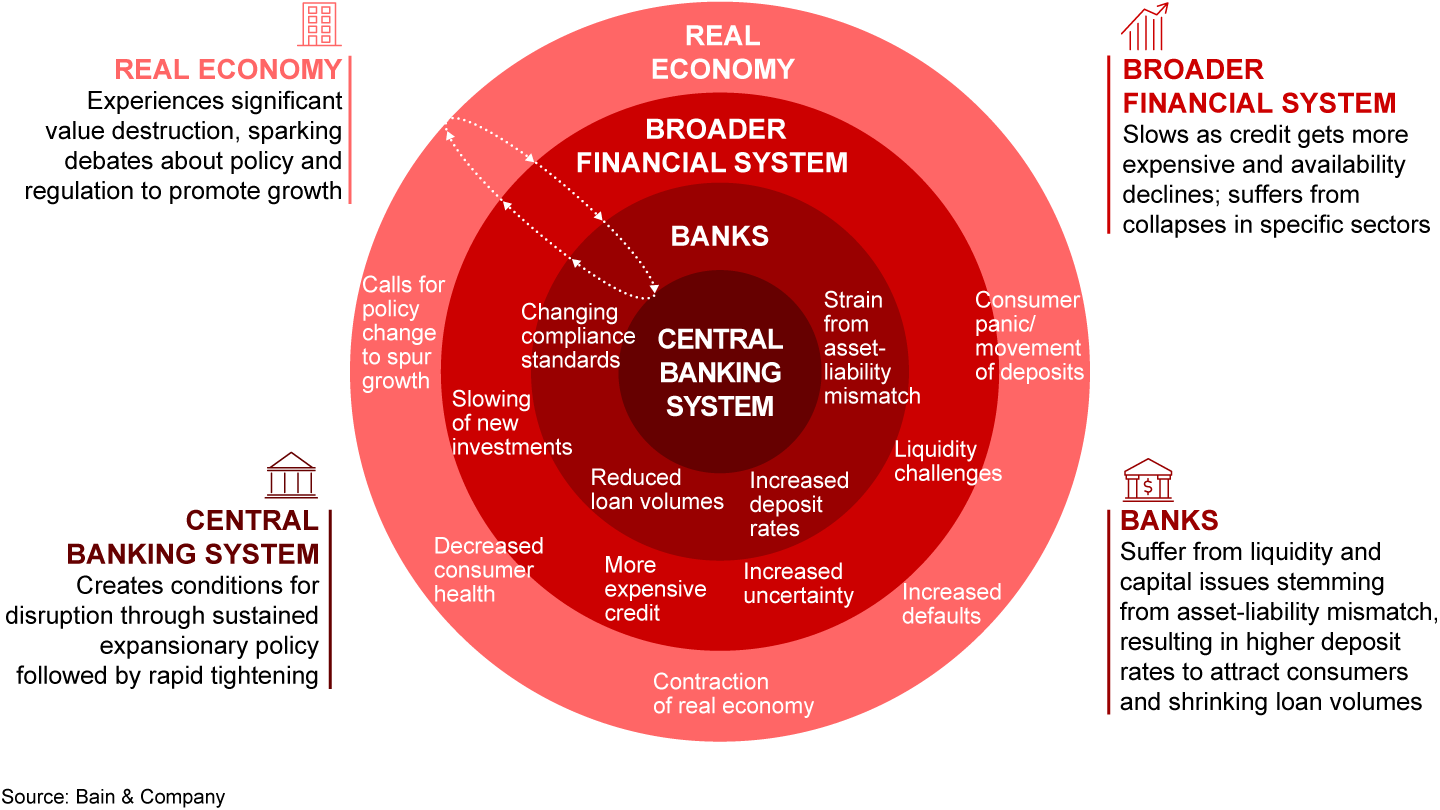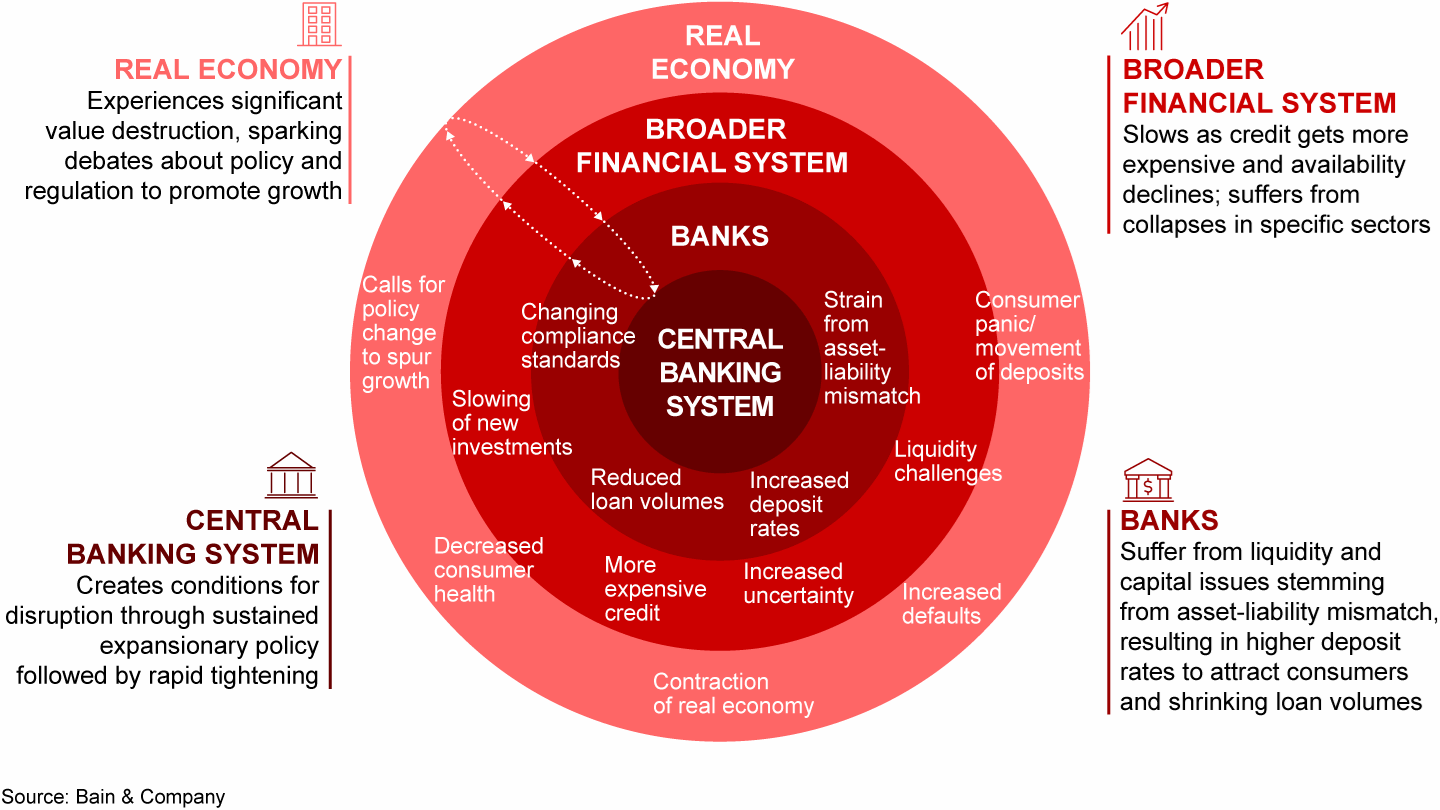Brief

At a Glance
- A cocktail of fiscal stimulus, loose monetary policy, and banks’ handling of excess liquidity has created new stresses on the US financial system as interest rates rise.
- The loss of equilibrium will persist and could spread to Europe, so banks must plan for multiple scenarios and develop strategic hedges around liquidity, capital, cost, and profitability.
- When the banking system and broader economy eventually find their footing, they will not revert to steady growth but instead enter a new regime characterized, at least initially, by high rates and greater volatility.
- Downcycles and uncertainty can present opportunities for banks that make the right bold, strategic moves.
The swirl of events that has enveloped Silicon Valley Bank (SVB), along with investor concern over the health of other US banks, signals a system in a state of disequilibrium. After more than a decade of relative stability following the global financial crisis, the yield curve inverted in 2019, indicating a potential turn in the business cycle just as the Covid-19 pandemic hit. The historic combination of fiscal stimulus and loose monetary policy in 2020 averted a possible pandemic-induced economic crisis, but it stopped the clock on the macroeconomic and credit cycles, ultimately creating new stresses that are now affecting the banking system and broader economy.
Banks largely benefited from these policies, with strong loan-to-deposit and liquidity-coverage ratios, and low delinquency and charge-offs for businesses and consumers. By 2022, banks had been deploying excess liquidity in investment securities—primarily shorter-dated US Treasuries and mortgage-backed securities—to extract yield without taking undue credit risk.
Banks rebalanced their investment securities portfolios classified as available for sale (AFS) or held to maturity (HTM), based on their appetite for potential mark-to-market losses. AFS losses would hit tangible common equity immediately, while losses in HTM portfolios would only be realized if banks were forced to sell in a crisis, such as one triggered by rapid deposit runoff. Industry ratios shifted from 2020 to 2022, with AFS securities as a share of all securities in the portfolio dropping from 78% to 60% on average for the top 30 US banks—and much more dramatically for some banks, including SVB. The investor focus on unrealized losses, failed capital raising, and a social media–induced deposit run on SVB highlighted the potential for broader asset-liability mismatches and liquidity and capital risks across the banking system.

Banking Liquidity: Is The Talk of Crisis Fair?
Listen to Episode 11 of Deciphered as experts dive into the current climate of fiscal stimulus, loose monetary policy, and banks’ handling of excess liquidity and attempt to answer the question: Is the talk of a banking crisis fair?
These truths endure
The disequilibrium that catalyzed these events is now reverberating across a highly interconnected system during a period of uncertainty (see Figure 1).

The uncertainty that we see in the US may spread to Europe, underscoring several enduring truths about the financial system:
- Liquidity is a critical driver of bank failures. Many participants may have had a false sense of security given that banks were well capitalized; there is always room for greater capital discipline.
- All participants are interconnected. Central banks, government regulators, and lawmakers set and enforce policy; businesses and individuals pursue their own interests; banks and financial intermediaries respond to client demand as they optimize risk and return. The choices made by each group create feedback loops in all parts of the system.
- Bubbles born from overly permissive monetary conditions often burst when policy shifts or trends revert. When this happens, the resulting disequilibrium reveals weaknesses (and strengths) among all the participants.
- While bank failures may be isolated, they often signify systemic stresses such as asset-liability mismatches. The feedback loops created by even a single bank failure can have consequences globally.
To be sure, the current situation differs from past crises. It’s marked by a retreat from globalization, the end of capital superabundance, and an era of shifting demographics. While we don’t see signs yet of a broader financial crisis, there are still distortions in the system that must be resolved. Credit concerns are now emerging alongside the widely anticipated recessionary pressures. Once the banking system and wider economy return to equilibrium, we will enter a new cycle characterized, at least initially, by higher interest rates, greater consolidation and competition, and more divergence in profitability.
Five practical actions to consider
Competitors that emerge strongest from a crisis analyze what success for their business should look like post-crisis and take bold actions to navigate the near-term disequilibrium. To that end, banks can get ahead of the next wave of events with a set of clear, no-regrets actions (see Figure 2).

Ramp up strategic scenario planning. The Federal Reserve’s stress tests do not fully probe the types of scenarios playing out now. Strategic scenarios should include sources of uncertainty and stress, as banks must be disciplined on returns and where they choose to deploy liquidity and capital—both high-priced resources in the near term. The balance of risk and return has shifted, and the discipline around capital and liquidity must sharpen accordingly.
Manage liquidity. With the near-term squeeze on perceived liquidity, markets are assuming the worst. Banks thus must get a handle on the feedback loop between liquidity and capital. In bank run situations, it’s critical to plan for worst-case scenarios while taking action to maintain confidence and optionality. This requires modeling and rapid decision making across balance sheet and income statement levers against multiple scenarios. Are your first- and second-line risk managers and asset-liability committees actively engaged in monitoring liquidity risks and controls?
Double down on capital discipline. Recent events remind us of the need for a “shock and awe” approach in times of crisis. Bold moves, capital raised, deals done—these build confidence among customers and investors. Actively managing capital ratios and taking actions on low-performing or low-risk/return businesses or assets will become even more critical.
Optimize efficiency. Markets want to hear clear, compelling messages on how banks will improve efficiency and deliver prudent growth. Margins will compress as funding costs rise and origination volumes are constrained, so banks must get costs under control—on the order of 10% in many cases. A zero-based approach, which takes a clean-sheet view of operational and capital expenditures, can trim costs quickly and become part of the equity story for investors.
Tell your story clearly and convincingly. The story is not just about stability and efficiency, but also growth. The influence of social media on investors and bank clients moving en masse is profound; indeed, social media catalyzed the run on SVB. No bank stock can be fully immune to this type of event. Smart communications, both quarterly and in real time, will be critical to recovering and sustaining confidence. This requires triaging and assessing the perspectives inside and outside the bank to produce a credible, refined, grounded equity story.
Within uncertainty lies opportunity, and the coming months will define what the industry league tables will look like a decade from now. Banks already in crisis mode may have limited strategic options. However, most banks have a chance to use this crisis to make strategic moves that inflect the core business. Continued disequilibrium will eventually give way to balance and then growth, yielding a new wave of banking leaders with commanding positions among clients, investors, and regulators.

